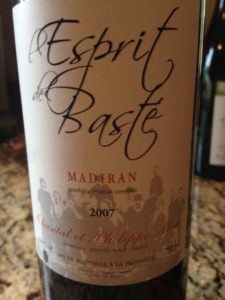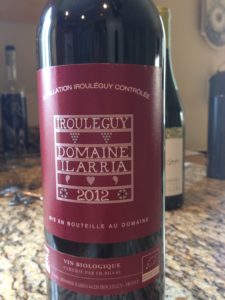Episode 148: Tannat Talk: A Grape Gab
We’re talking Tannat in this month’s Grape Gab. Tannat is a red grape that has its roots in Southwestern France. Recently it has reinvented itself in South America. So where else does it grow, what else is it called, and what does it mean to a glass of wine? Click play and sip away!
In the Glasses This Week (1:00)
 Steph: 2013 Vinicola Perini Macaw Tannat from Brazil… and it is only 11.5% abv. What?! This is an Italian family business with fun marketing and crazy wine cocktails listed on their website. ($13.19)
Steph: 2013 Vinicola Perini Macaw Tannat from Brazil… and it is only 11.5% abv. What?! This is an Italian family business with fun marketing and crazy wine cocktails listed on their website. ($13.19)
Steph & Val: 2015 Bodega Garzon Tannat Reserve from Uruguay. It is estate grown fruit, hand harvested, and aged in French oak. Garzon was founded by the Italian family Bulgheroni and operates under an Italian enologist Alberto Antonini. ($14.95)
Discussion: Tripping on Tannat – A Grape Gab (4:14)
February’s Grape Gab is all about the Tannat grape.
What it is:
It is known for its role in the legendary “Black Wines of Cahors” to supplement, along with Merlot, the Côt or Malbec.
But is also the main component in Madiran (which is also one of its synonyms), and it is here, in the 18th century, that the grape was first mentioned.
This is one region that we unfortunately see less often on the shelves. In this case Tannat makes up 60 – 80%, with Cabernet Sauvignon, Fer Servadou, and Cabernet Franc (or Bouchy) bringing the blend home.
Tannat by any other name (5:50)
The Basque word for Tannat is Bordelez Beltza, but it can also be called Madiran, as we mentioned, and Moustrou. In Uruguay, which is what we’re drinking today, it can be called Harriague.
Where it grows (6:40)
Although it hails originally from Southwest France, Uruguay is its second home, thanks to the Basque settlers who brought Tannat and Manseng to Uruguay. It also is quite cozy in Virginia and in California thanks to Tablas Creek Vineyards in Paso Robles! But Tannat has traveled all over the world and can be found in Australia, Argentina, Brazil, Bolivia, South Africa, Switzerland, and Sicily.
Some obscure areas of SW France, such as Iroulèguy, grow Tannat and make more approachable reds and rosés, but overall plantings in France are declining.
In the vineyard, Tannat is easy to grow, frost hardy and not prone to overproduction or mildew. However, it does have thick stems which can make de-stemming difficult.
What it does in the glass (8:39)
We already dropped a hint as to the color of the wine, usually inky and dark in the glass. This leads us to the nose and the palate. While “not messing around,” is not official tasting terminology found in most grids, we did mention that the name “tannat” implies “tannins.” So, depending on how the wine was made, the wine can have incredible astringency or drying sensations in the mouth.
In Uruguay, Tannat, which is also called Harriague, thrives in the warm climate, but winemakers tend to soften the tannins by blending it with Pinot Noir and Merlot. Other wine making techniques, such as micro-oxygenation, can and are used to make it more drinkable and consumer friendly too. There are also port and Beaujolais styles of Tannat in Uruguay.
What you can expect in a glass of dry, red Tannat wine is layer upon layer of spice, red, black and/or blue fruits depending on where it is grown, earthiness and structure.
Wine making chatter (10:00)
We also understand there is some carbonic maceration going on in Uruguay, too, and blending with Merlot; this harkens to the Beaujolais style Steph mentioned earlier. Lynn actually got to taste these in her award-nominated piece on Uruguay wine exploration: https://savortheharvest.com/explore-wine-uruguay/.
So in the event the wines aren’t manipulated with micro-oxygenation, these wines typically require some aging to allow the tannins to soften. So how does that softening happen in bottle? Polymerization, people! The molecules get all happy and bind together, which rounds out their texture. Also, the molecules get heavier, which is part of the reason the wines not only soften with age, but also precipitate out in the form of sexy sediment.
Drink more Tannat! (14:00)
Inquiring Steph wants to know, why aren’t wine lovers and collectors buying the best examples of Tannat, be it French, Uruguayan, or America n, and laying those bottles down for 20-30 years? Maybe there should be a taste-off competition like the Judgement of Paris, New World vs Old World, but with Tannat wines instead.
n, and laying those bottles down for 20-30 years? Maybe there should be a taste-off competition like the Judgement of Paris, New World vs Old World, but with Tannat wines instead.
Bottom line, there’s not a lot of it.
However, be on the lookout not just for wines from Madiran and Uruguay, but other Southwest France regions like Irouléguy’s Domaine Ilarria. The one we really enjoyed was at a “French Fringe Wine Fun” dinner in 2015, and it was 70% Tannat. Tursan, Béarn, Brulhois, and Coteaux du Quercy – all hailing from Southwest France – are also appellations that use Tannat as blending grapes.
Factoid / Burning Wine Question (18:00)
Mairi in Germany asked, “What‘s the difference between wiessherbst and weis gekeltert?”
Wiessherbst, “white autumn” or “white harvest”, is German rosé wine made by a single variety. This pink wine is made from red grapes (i.e. Spatburgunder) and is either QBA or QMP. This German term is also used in Switzerland.
Weis gekeltert is German for “white pressed” or “white-vinified”. Have you ever seen or tasted a white Merlot or a white Pinot Noir? Weis gekeltert is the German term for making a white wine with red grapes by gently pressing the red grapes to only extract the white juice. It is also the name of a German winery in Wurttemberg.
Actually, the Dr. von Basserman-Jordan Blanc de Noir drunk on this show several times is a great example of weis gekeltert! It was this sick, white wine that was a Cabernet and Pinot Noir blend. They’ve added Merlot in more recent vintages.
Winoradar (21:00)
OPP: Other peoples’ podcasts
Wine Enthusiast Podcast launched Season Three. Highlights include:
- Wine and wellness, because the two are not opposing forces. Pro-tips for making good mocktails and a sober Master of Wine (we know who that is …)
- Ordering wine in a restaurant and looking confident
- American Single Malts vs Scotch
Visit winemag.com/podcast/ to check it out!
More of the Tannat story
Society of Wine Educators have 2 SWEbinars in May!
Wednesday, May 23rd at 7pm and Saturday May 26th at 10am central time: Let’s talk Tannat—a Taste-along webinar presented by Jane A. Nickles, CSE, CWE: Wine students will recognize the Tannat grape variety as the main grape of the Madiran AOC and as the super-star grape of Uruguay…but there’s more to story of Tannat! Join us for this one-hour webinar discussing the history, wines, and future of the Tannat grape.
Patreon Love (24:00)
Thank you to our Patrons who support us on the crowdfunding platform called Patreon!
“TENacious Tasters”
- Jeff E from the We Like Drinking podcast
- Lynn from Savor the Harvest blog
- Sebastian of Sassi Italy Tours
- Jen in Maryland (and the world, according to her Instagram feed)
- David and Lisa in Illinois
- Ann Marie in Virginia
“It’s not five o’clock and we don’t care” Listeners
- Meg in South Dakota
- Clay in Arizona
- In California – Jon, Andrew, Aswani
- Chantel in Ontario, Canada
- Mary Lou in Pennsylvania
- Cathie in Georgia
- In Colorado – Chris and Janet, Diane
- In Illinois – Steve, Renee
- Cathey in Tennessee
- Ashley in North Carolina
- Sean in Ohio
“Tastemaker Listeners”
- David in Scotland
- Carole in Kentucky
- Karen in California
Connect: (26:00)
We are here for you every week. Between episodes you can find us on the social spaces @WineTwoFive and we encourage you to join our private FaceBook group called Wine Two Five Community!
Connect with Val on Twitter @WineGalUnboxed and as Vino With Val on Facebook, Instagram & Pinterest.
Connect with Steph on online as @TheWineHeroine.